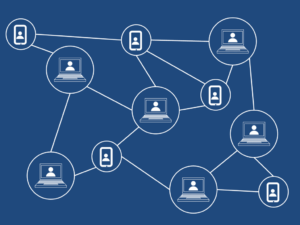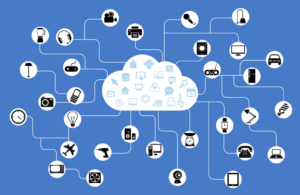Blockchain Industrial Revolution
Looking the Future & Technology in the Eye
Think back to the early days of the internet. How did you first use it? How has your use transformed through the years? My guess is that you’ve experienced a significant shift toward being more connected online, whether that be through your social media accounts, banking, investing, or shopping apps, your work and personal email accounts, a fitness or step-tracking app, or in some other way.
Our personal and professional lives continue becoming more and more connected. With blockchain, smart contracts, the “internet of things,” and distributed ledgers, we’re looking at the exciting future of technology right in the eyes.
Just like the internet, these technologies can transform your business and personal life in very impactful ways – saving time, driving efficiencies, increasing transparency, and more.
Blockchain: Transforming Society & How We do Business
On one side, we have blockchain defined as a technology solution that helps us escape government oversight and ensure that we have a virtual currency that is accessible to everyone.
 On the other side, blockchain is described as a movement that will change humanity and ensure that we can trust each other when trading goods and services. The initial adoption is slow and painful, but eventually, every commercial contract will have at least one blockchain aspect to it.
On the other side, blockchain is described as a movement that will change humanity and ensure that we can trust each other when trading goods and services. The initial adoption is slow and painful, but eventually, every commercial contract will have at least one blockchain aspect to it.
With these two differing opinions, one thing is certain. Blockchain will change $100 trillion valued global transactions by utilizing smart contracts, the internet of things, and distributed ledgers.
In a March 2019 interview with Nasdaq, Alex Mashinsky, Celsius CEO and inventor of VoIP predicted blockchain systems in the future will be 1000 times the size of today’s internet. In this interview, he compares telephones in the 1990s with the transition to and adoption of the internet.
Buzzwords like blockchain, artificial intelligence, and the internet of things garner much attention. But what about smart contracts?
What is a Smart Contract?
A smart contract is a contract between two or more parties that have agreed to exchange value under certain terms that are converted into computer code. The computer code stores the conditions that need to be met before payment can be made for purchased goods or services.
A traditional contract is not usually evoked unless there is a disagreement between the two parties transacting. When goods or services are received by the buyer in accordance with the contract and signed off on paper by one of the buyer’s representatives, the seller sends an invoice that eventually gets paid.
Smart contracts have the power to automate the process and help you better track the deals you make. Realistically, this process will never be 100% automated, but radical change is coming, and the roles and responsibilities of the parties involved – like courts and lawyers – will look drastically different.
Smart contracts challenge supply chains to work together with legal and operations teams to convert contracts into code to simplify logistics. In doing so, steps that humans would normally do are replaced with sensors that can act as “trusted” intermediaries to record relevant instances of the smart contract.
Internet of Things Sensors
 These sensors that help measure and fulfill smart contracts may just be in our pockets. Studies by Gartner show that by 2020, there will be 26 times more devices connected to the internet than there are people living globally. Furthermore, every second, another 127 devices are connected to the internet, according to McKinsey. That means there are expected to be more than 75 billion internet of things devices worldwide by 2025.
These sensors that help measure and fulfill smart contracts may just be in our pockets. Studies by Gartner show that by 2020, there will be 26 times more devices connected to the internet than there are people living globally. Furthermore, every second, another 127 devices are connected to the internet, according to McKinsey. That means there are expected to be more than 75 billion internet of things devices worldwide by 2025.
All these sensors and devices that are connected to the internet are potential candidates for measuring smart contract fulfillment rates. As we become more integrated, we will have more transactions done virtually with minimal human interaction.
Distributed Ledgers
Distributed ledgers keep a record of all transactions that happened in accordance with the code from smart contracts. The detail of the transaction is kept in the database connected to a smart contract and measured by smart devices connected to the internet.
The Linux Foundation started a Hyperledger project in 2015 that is an umbrella for all open-source blockchains and related applications. Intel, SAP, and IBM contributed over 600 different smart contracts and 40,000 lines to the Hyperledger project. Distributed ledgers can automatically record information received from sensors without human input. This reduces the amount of time and people involved in tracking and recording transactions. Can you imagine?
A Lot of Pieces of the Business Puzzle in Motion
It’s an exciting time to look technology in the eye and prepare for the future and all that will be impacted with the help of blockchain. Just like with the internet, the movement will continue to gain momentum as more people gain an understanding of the value blockchain brings to our lives. Rest assured that the blockchain engine that powers our activity on the internet is here to stay and its importance will only increase over time!



